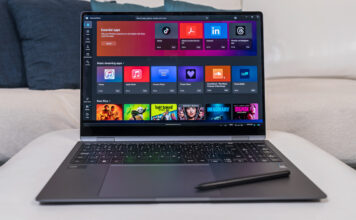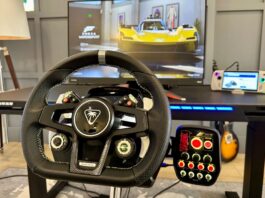![]()
Google goes in a different direction with the Pixel 5, yet retains so much of its familiarity that it will either draw you in or wave you back.
Don’t mistake the Pixel 5 as a true flagship because it’s really more of a higher-end mid-range device. That’s by design, though, as Google prefers to stay within less expensive ranges this year. And that creates an opening for anyone who might have considered a Pixel before, yet couldn’t justify the cost.
There is the Pixel 4a as an alternative, and now there’s a 5G variant of that device, too. In going with one size for the Pixel 5, Google simplifies the options, and this will be as big as it gets for the line until next year.
Google Pixel 5 SpecsDisplay: 6-inch 2340 x 1080 OLED display 19:5:9 aspect ratio with 432 pixels per inch |
Pixel 5 design
Google never gave its Pixel phones radical makeovers or dramatic design treatments. The colours have been pretty good, as the sorta sage model shows this year, but others are far more experimental. This company clearly prefers a design philosophy that stays muted on hardware because it’s about the software.
I’ll get to that part further down, but let’s not overlook just how understated this phone is. My black review unit is pretty drab, though putting one of Google’s fabric cases gives it some character. Look closer, and you notice some useful changes. I really like the aluminum body as an alternative material choice, and feel the same way about the brushed treatment over it. It makes the phone easier to grip, while attracting fewer fingerprints.
Google also cut out a hole in the aluminum back to accommodate the wireless charging coil back there. It also works in reverse, letting you charge devices by placing them on the back. It also made room for a fingerprint sensor in the back that was sorely missing last year.
The 6-inch OLED display is nice, with an adaptive 90Hz refresh rate you can turn on by choice. It only kicks in when it needs to, which is likely a battery-saving move, so you may notice it at some points. While having a larger screen and aluminum body, the Pixel 5 feels smaller and lighter. Google trimmed the bezels around the display, putting the hole-punch front-facing camera in the corner.
Under the hood, you get the Snapdragon 765G processor, with 8GB of RAM with 128GB internal storage. It’s all the indication one needs to see this isn’t in flagship territory, but the point is to meld affordability with performance.
![]()
Software that still performs well
Don’t expect a huge list of new features because they’re not here, and those that are available aren’t going to be exclusive to it. What I’ve always liked about Google’s approach is that it introduces features that try to address actual real-world concerns. For instance, Hold for Me will stay on the line for you while you’re on hold until Google Assistant tells you someone’s ready to talk to you.
The Recorder app, which was one of the best things to come out of the Pixel 4, now offers editable text. You can delete what you either don’t need or what isn’t accurately transcribed. For something that works offline, it’s a super cool thing to have for meetings, lectures and interviews. There’s even a new built-in screen recorder function you can find under the notification pane’s shortcuts.
Google also remapped the power button so when you press and hold it, a new menu pops up. It shows you shortcuts to Google Pay cards and smart home devices; convenient when you want quick access, though I do hope Google expands it further.
It’s easier to respond to messages within the notification pane. And if an app asks you for permission access to do something, you can choose to do it only that one time you need it.
Most, if not all, of these will make their way to the Pixel 4a, Pixel 4 and on down to earlier models. Google guarantees three years of updates, including what they call “feature drops,” so it would line up with that cadence.
![]()
Doing more with less
Despite its lack of more powerful silicon under the hood, the Pixel 5 works just fine. I never encountered any serious hiccups, though I would be weary of really intense games where processing power matters. The 8GB of RAM is sufficient for multitasking needs, and the internal storage is fine. There’s no way to expand that, but Google Photos can be a real help saving images to the cloud.
I could edit RAW photos I shot on the phone with ease. Playing casual games was fine, as was streaming a soccer game on DAZN, or video on any of the popular platforms. Everything from web browsing to messaging and social media was exactly as I expected it would be.
Still, I can see why some would worry about the lack of horsepower. If you’re a heavy user who really pushes a phone’s performative chops, then I would be cautious, too. But I imagine that will be a minority of users.
Amazing camera, but the gap is closing fast
Google’s camera magic has long been software-based, considering the hardware hasn’t changed that much over the years. The 12.2-megapixel image sensor and f/1.7 aperture for the main lens are basically the same in the Pixel 5. Only Google swapped out the Pixel 4’s telephoto lens in favour of a 16-megapixel ultra-wide one. Why not keep all three lenses?
My guess is to reduce costs, but Google says it’s because the main lens’ Super Res Zoom is good enough to replace most of what the telephoto lens can do. That’s just not the case, and you won’t need me to prove it. While the feature is pretty impressive, it loses detail as it zooms in, also reducing the number of pixels in the frame.
On the other hand, the ultrawide lens addresses a gaping hole in the Pixel’s camera array. And it’s a great addition, capturing so much more in a frame with the same software computation. The results are great, as they often are with the main lens, too.
But I couldn’t help wondering what the images might’ve looked like with a larger image sensor. Competitors are taking hardware more seriously, and I’d love to see how some of that would apply to Google’s computational photography prowess.
For what it’s worth, the new things do matter. Night Sight for Portrait mode shots is huge, and works well. Night Sight even kicks in for the main camera mode (the moon icon), though you can also turn that off. Portrait Light also kicks in to automatically illuminate a face using machine learning. You can adjust that when editing later, but the initial results are often impressive, no matter where you are. These features also apply to the front-facing camera, which is great for selfies.
Shooting video with more tools
It’s about time Google took video more seriously, and it begins with the option to shoot 4K at 60fps with the Pixel 5. The previous 30fps limit felt punitive, so it’s good Google unshackled that. Footage benefits from the faster framerate, especially when capturing movement.
But it’s the new video modes that will be really fun to experiment with. Cinematic Pan probably stands out the most because it’s the most creative. It basically shoots at 60fps and then dials back the framerate to 30fps so you get a slower panning effect. This works best when either you or a subject is moving, but it’s very open to interpretation.
Speaking of moving, the other two modes are focused there, too. Active is kind of like Cinematic Pan but without the framerate swap. In this case, the phone switches to the ultra-wide lens and lets you zoom in to help stabilize your shot. It’s really just cropping in to do it, which is also why it reduces max resolution to 1080p HD. Since Google demoed this mode on a jet ski, I’m assuming its purpose is for faster action scenes.
Then there’s Locked, which zooms in 2x and “locks” onto the subject to reduce any jittery hands. It’s not bad, except it reduces the overall image quality by zooming in, and is at its best when using it in great lighting. At night or in low-light, the feature can go off the rails.
As for standard video, Google threw in audio zooming, where the microphones hone in on a subject as you zoom into it. LG and Samsung have done it before, so it’s not new, but it’s here on the Pixel 5 if you need it.
Battery life
Given how poorly the Pixel 4’s battery ultimately lasted, Google had a low bar to hurdle over. While it’s hard to know the longer-term assessment, I can say the Pixel 5 is far better at retaining battery life than its predecessor was.
Squeezing in a bigger battery certainly helps. So does using a more efficient processor. Google’s Adaptive Battery mode also does its part. The latter came with the Pixel 4a, and it’s supposed to tap into the battery when a task truly needs the juice, whereas idle times vastly reduce any loss.
Extreme Battery Saver is cool, but I can only see people using it on the rare occasion when the device really isn’t going to make it long enough until it charges. I found it could also be useful for as a sort of ‘do not disturb’ mode because it blocks all notifications until you open an app that may have one. You save plenty of battery life, while also staying focused on something else. Sure, the Do Not Disturb mode already does that, but it doesn’t necessarily block notifications the same way.
With all that in mind, I had no problem going a full day with this phone as my daily driver. It was also really convenient to wirelessly charge it, while the wired 18W charger was quick.
5G connectivity
Yes, this is a 5G-enabled phone, but that’s not a big deal—yet. In Canada, carriers aren’t rolling out their new networks all that fast. If you are to take advantage of the extra speeds, you would probably need to be in a big city sometime in 2021.
Final thoughts
That the Pixel 5 moves away from real luxury territory makes it appealing from the outset. Google no longer expects you to pay a serious premium for its phones this year and into 2021. Its product lineup this year makes that really clear. Does it matter that it’s not a flagship? Not in my opinion because it’s actually the mid-range phones that have proven to be the most compelling this year.
Google fixed the most pertinent issues stemming from the previous iteration. But the Pixel 5’s features are also coming to the other Pixels, so you may be paying for an ultra-wide lens and the Hold for Me feature at the end of the day. This is a solid handset worth at the top of the Pixel pack, and far better value than what you used to pay for Google’s flagships.
The Google Pixel 5 is available now in just black and sorta sage.


















































